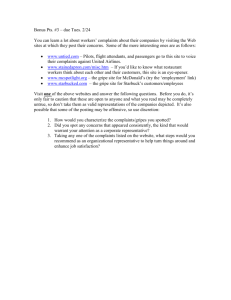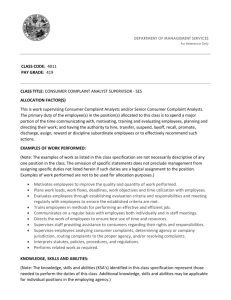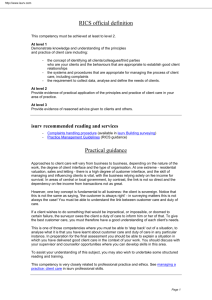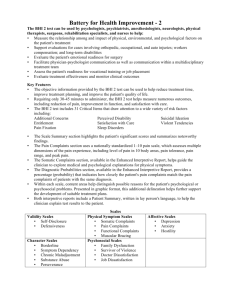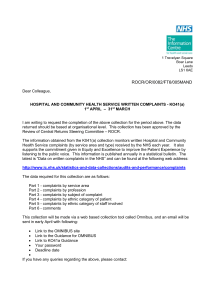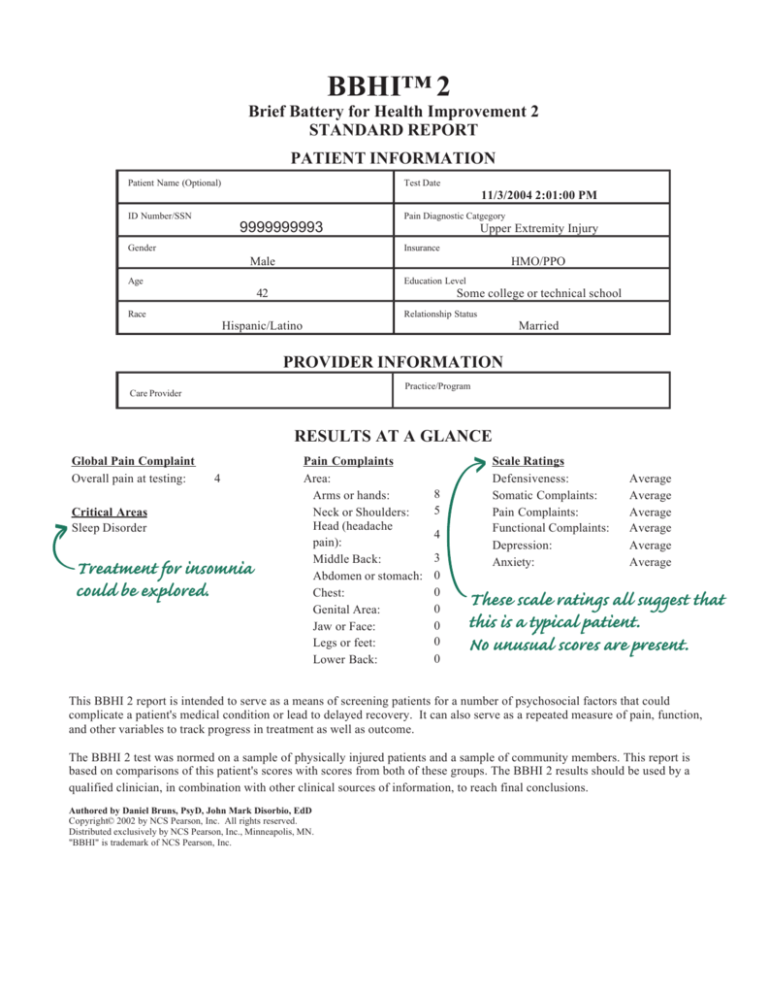
BBHI™ 2
Brief Battery for Health Improvement 2
STANDARD REPORT
PATIENT INFORMATION
Patient Name (Optional)
ID Number/SSN
Test Date
9999999993
Gender
11/3/2004 2:01:00 PM
Pain Diagnostic Catgegory
Upper Extremity Injury
Insurance
Male
Age
HMO/PPO
Education Level
42
Race
Some college or technical school
Relationship Status
Hispanic/Latino
Married
PROVIDER INFORMATION
Practice/Program
Care Provider
RESULTS AT A GLANCE
Global Pain Complaint
Overall pain at testing:
4
Critical Areas
Sleep Disorder
Treatment for insomnia
could be explored.
Pain Complaints
Area:
Arms or hands:
Neck or Shoulders:
Head (headache
pain):
Middle Back:
Abdomen or stomach:
Chest:
Genital Area:
Jaw or Face:
Legs or feet:
Lower Back:
8
5
4
3
0
0
0
0
0
0
Scale Ratings
Defensiveness:
Somatic Complaints:
Pain Complaints:
Functional Complaints:
Depression:
Anxiety:
Average
Average
Average
Average
Average
Average
These scale ratings all suggest that
this is a typical patient.
No unusual scores are present.
This BBHI 2 report is intended to serve as a means of screening patients for a number of psychosocial factors that could
complicate a patient's medical condition or lead to delayed recovery. It can also serve as a repeated measure of pain, function,
and other variables to track progress in treatment as well as outcome.
The BBHI 2 test was normed on a sample of physically injured patients and a sample of community members. This report is
based on comparisons of this patient's scores with scores from both of these groups. The BBHI 2 results should be used by a
qualified clinician, in combination with other clinical sources of information, to reach final conclusions.
Authored by Daniel Bruns, PsyD, John Mark Disorbio, EdD
Copyright© 2002 by NCS Pearson, Inc. All rights reserved.
Distributed exclusively by NCS Pearson, Inc., Minneapolis, MN.
"BBHI" is trademark of NCS Pearson, Inc.
BBHI TM 2
ID:
9999999993
Page 2
A raw score of 0 is the lowest possible score.
Standard Report
Brief Battery for Health Improvement 2
Patient Norms Profile
Scales
Raw
Score
Validity Scale
Defensiveness
13
Physical Symptom Scales
Somatic Complaints
3
Pain Complaints
20
Functional Complaints
11
Affective Scales
Depression
4
Anxiety
5
INTERPRETING THE PROFILE:
T Scores
Patient Comm.
10
T-Score Profile 1
40
50
60
Rating
Percentile
2
90
49
43
Average
44%
42
45
46
46
52
56
Average
Average
Average
25%
38%
35%
43
43
47
47
Average
Average
23%
24%
1
The T -Score Profile plots T-scores based on both patient and community norms. Approximately 68% of the samples scored between the average
range of 40 to 60. Above or below this is clinically significant.
2
The Percentile is based on the patient T-scores.
When viewing the T-Score Profile, the longer the bar, the more significantly the score deviates from the mean. One bar outside the average range is
significant. Both bars outside is more significant.
Critical Items
The Client responded to the following critical items in manner that is likely to be of concern to the clinician.
Sleep Disorder
I've had no problems with sleeping. (Disagree)
Critical items point out specific problems
that the patient reported.
Page 3
Test Administrations
BBHI TM 2
Progress Report
ID:
9999999993
Name:
11/3/2004 2:01:00 PM
T Score Norms: Patient
Pain Diagnostic Category: Upper Extremity
Injury
100
100
100
80
80
80
60
T
60
T
60
40
40
40
20
20
20
0
0
Somatic Complaints
100
80
80
60
0
Pain Complaints
100
T
T
60
T
40
40
20
20
0
0
Depression
Anxiety
10
10
8
8
6
6
4
4
2
2
0
0
Level of Pain at Administration
Upper Extremity Injury
Functional Complaints
BBHI TM 2
ID:
9999999993
Page 4
Standard Report
CLINICAL SUMMARY
VALIDITY: Valid
Any validity concerns are reported here.
DEFENSIVENESS: Average
There were no indications that the patient attempted to bias his responses to look either better or worse. This testtaking attitude supports the validity of the patient's self-reports.
SUMMARY OF FINDINGS:
There may be an objective basis for this patient's reports of localized severe and intolerable pain. If so, his profile
suggests that he is coping with the emotional stress of this fairly well. However, if there is no objective corroboration
of these reports, his profile may suggest that factors in his psychosocial environment (such as high levels of support
or secondary gain) offset the emotional distress that might otherwise be expected and may reinforce his pain
complaints. Psychological treatment for pain management should be considered.
This paragraph integrates all of the significant BBHI 2 scale findings.
SOMATIC COMPLAINTS: Average
Although his overall level of somatic complaints is not unusual for a patient, some troubling somatic complaints
were noted.
PAIN COMPLAINTS: Average
Although there was no broad pattern of pain complaints, severe peak pain was reported.
FUNCTIONAL COMPLAINTS: Average
No unusual disabilities or difficulties with activities of daily living were reported. Such patients are reporting that
they perceive themselves as having a generally intact ability to work and function.
DEPRESSION: Average
No unusual depressive thoughts and feelings were reported. The critical item list should be checked for vegetative
depressive symptoms.
ANXIETY: Average
No unusual anxious thoughts and feelings were reported. The critical item list should be checked for autonomic
anxiety symptoms.
BBHI TM 2
ID:
9999999993
Page 5
Standard Report
PAIN COMPLAINTS ITEM RESPONSES
The pain ratings below are based on a scale of 0 to 10 (0 = No pain, 10 = Worst pain imaginable). The degree to
which the patient's pain reports are consistent with objective medical findings should be considered. Diffuse pain
reports, a nonanatomic distribution of pain, or a pattern of pain that is inconsistent with that reported by patients
with a similar diagnosis increases the risk that psychological factors are influencing the pain reports.
AREA
Head (headache pain):
Jaw or face:
Neck or shoulders:
Arms or hands:
Chest:
Abdomen or stomach:
Middle back:
Lower back:
Genital area:
Legs or feet:
PATIENT
4
0
5
8
0
0
3
0
0
0
MEDIAN*
4
0
6
7
0
0
2
3
0
2
Overall highest level of pain in the past month:
Overall lowest level of pain in the past month:
Overall pain level at time of testing:
Maximum Tolerable Pain:
8
2
4
6
8
2
Pain Range:
Peak Pain:
Pain Tolerance Index:
6
8
-2
*Based on a sample of 220 patients with upper extremity pain/injury.
Pain reports are all
very similar to the
average reports of
other patients in the
same diagnostic
category. This is
what you would
expect the patient
to report.
BBHI TM 2
ID:
9999999993
Page 6
Standard Report
The optional Patient Summary you selected is printed at the end of this report. At your discretion, you may give this
to the patient to encourage his understanding of and participation in the rehabilitation program.
ITEM RESPONSES
1:
11:
21:
31:
41:
51:
61:
4
8
0
1
2
0
1
2:
12:
22:
32:
42:
52:
62:
0
2
0
2
0
0
1
3:
13:
23:
33:
43:
53:
63:
5
4
0
3
2
2
0
4:
14:
24:
34:
44:
54:
End of Clinical Report
8
6
0
1
2
1
5:
15:
25:
35:
45:
55:
0
1
0
1
2
1
6:
16:
26:
36:
46:
56:
0
0
3
2
0
1
7:
17:
27:
37:
47:
57:
3
0
2
0
2
2
8:
18:
28:
38:
48:
58:
0
2
1
1
1
2
9:
19:
29:
39:
49:
59:
0
0
1
0
2
0
10:
20:
30:
40:
50:
60:
0
0
1
0
0
0
BBHI TM 2
ID:
9999999993
You can give this summary to your patient or
use it to generate ideas about how to present
verbal feedback.
Page 7
Standard Report
PATIENT SUMMARY
The following are the results of your BBHI 2 test. These results were generated by a computer analysis, which
compared your responses on this test to the responses of national samples of rehabilitation patients and of
nonpatients in the community. This analysis indicates that you are reporting the following significant information
about yourself. It is important to remember that the computer can form hypotheses about your current condition,
but only your doctor can form a final opinion about what the results of this test actually mean. If you feel that any of
the following statements are incorrect, you should discuss this with your medical caregivers. Additionally, if the
following interpretation seems to miss important points about you that your doctor or other caregivers should know,
you should use this opportunity to share this information with them.
You approached the test in an even-handed manner, with no apparent tendency to either minimize or magnify
your concerns.
Your profile indicates that you are experiencing localized severe pain. Patients with this profile tend to be very
concerned about their pain and focused on seeking pain relief. Whatever the source of your pain, it is important to
remember that there are many effective treatments available. It is important to discuss with your doctor the nature
of your pain, factors that aggravate it, and the type of treatment that is most likely to be effective for you.
Your profile indicates that you are reporting a level of physical illness symptoms that is comparable to what is
experienced by the typical nonpatient in the community.
Your profile indicates that you are reporting a level of functional difficulties that is comparable to what is
experienced by the average "normal" person in the community.
Your profile indicates that you are not reporting any unusual degree of negative thoughts or sadness.
Your profile indicates that you are reporting a level of anxious thoughts and feelings that is comparable to what is
experienced by the average "normal" person in the community.
End of Report

